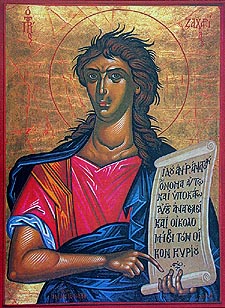Prophet Zachariah

The Prophet Zachariah the Sickle-Seer the eleventh of the twelve Minor Prophets. He was descended from the tribe of Levi, and seems to have been a priest (Nehemiah 12:4,16). He was called to prophetic service at a young age and became, in the wondrous expression of church hymnology, “a spectator of supra-worldly visions.”
The Book of the Prophet Zachariah contains inspired details about the coming of the Messiah (Zach 6:12); about the last days of the Savior’s earthly life, about the Entry of the Lord into Jerusalem on a young donkey (Zach 9:9); about the betrayal of the Lord for thirty pieces of silver and the purchase of the potter’s field with them (Zach 11:12-13); about the piercing of the Savior’s side (Zach 12:10); about the scattering of the apostles from the Garden of Gethsemane (Zach 13:7); about the eclipse of the sun at the time of the Crucifixion (Zach 14:6-7).
“Enlightened by dawnings all above,” the Prophet Zachariah, “saw the future as it were the present.” According to Tradition, this “most true God-proclaimer” lived to old age and was buried near Jerusalem, beside his illustrious contemporary and companion, the Prophet Haggai (December 16). The title “Sickle-Seer” given Zachariah comes from a vision in which he saw a sickle flying in the air, destroying thieves and perjurors (Zach 5:1-3).
The holy Prophet Zachariah died around 520 B.C. His tomb was discovered in 415 in a village near Eleutheropolis (Sozomen, Hist. Eccles. VI:32, IX:17). At the prophet’s feet was the body of a child dressed in royal accoutrements. His holy relics were transferred to the church of Saint James the Brother of the Lord (October 23) in Constantinople.
